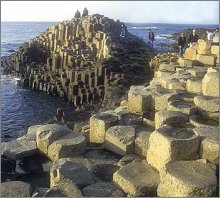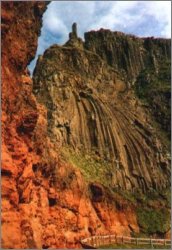Giant's Causeway in Ireland:
Unusual & Interesting Tourist Destinations #4
by www.SixWise.com
When the Giant's Causeway in Ireland was first discovered
in 1693, debate arose as to whether the impressive landscape
was formed by men, nature or the efforts of Finn MacCool,
a gentle giant who, according to legend, built the causeway
to bring his lady giant love interest across the water to
him.
|

The impressive Giant's Causeway is made up of 40,000,
mostly hexagonal, stone columns.
|
It wasn't until nearly 100 years later in 1771 that a Frenchman
uncovered the causeway's real maker: volcanic eruptions and
quickly cooling lava some 50 million to 60 million years ago.
The Giant's Causeway is most famous for its unique columnar
structure, which is made up of 40,000, mostly hexagonal, stone
columns, some up to 40 feet high (and solidified lava in the
cliffs as thick as 90 feet).
Giant's Causeway: What to See
Every year, a half-million visitors come to North Antrim's
magnificent coastline to gaze in awe at the columns of the
Giant's Causeway. The tops of the columns resemble stepping
stones starting from the cliff base and disappearing under
the sea.
Some of the stone structures also closely resemble objects,
and have been named as such. Visitors should be sure to see
the Chimney Stacks, the Harp, the Pipe Organ, the Giant's
Boot and the Camel's Hump. There are also impressive circular
formations around a nugget of basalt, which have been dubbed
"giant's eyes."
Aside from the geology, Giant's Causeway is home to a number
of sea birds, including fulmar, petrel, cormorant, shag, redshank
guillemot and razorbill, along with other unique bird species
like rock pipits, wagtails, and eider duck.
|

The Giant's Harp, one of several "objects"
formed into the rocks.
|
There are also a number of rare plants to be found in the
area, such as sea spleenwort, hare's foot trefoil, vernal
squill, sea fescue, frog orchid, and sea campion.
And, for the slightly more adventurous, there is the Carrick-a-rede
rope bridge, which stretches from the coast to a small fishermen's
island. Adventurers are welcome to cross the swinging bridge,
if they're willing to brave the 80-foot drop.
Planning a Visit
Admission to the causeway is free (donations welcome), and
visitors can get there via local train or bus. The area is
open from 10 a.m. to 5 p.m., seven days a week (November to
February, 10 a.m. to 4:30 p.m.), and is closed December 24-27.
For more information, please visit:
Recommended Reading
The
House on the Rock: Unusual & Interesting Tourist Destinations
The
Catacombs of Paris: Unusual & Interesting Tourist Destinations
Sources
The
Giant's Causeway: The Official Guide
The
Giant's Causeway
The
National Trust: Giant's Causeway